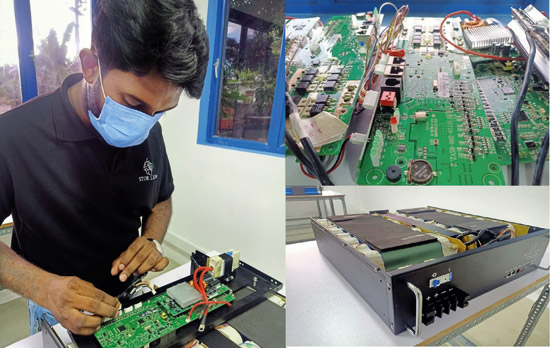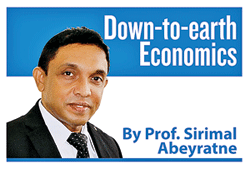“Old fashions may change”
View(s):Based on a different set of statistics, I am sure someone else could say that Singapore is an “industrialised” economy, and it is more “industrialised” than India. Let me highlight the fact that Singapore has exported $515 billion worth merchandise goods in 2022 which is even greater than its GDP. Moreover it’s total merchandise exports almost consist of manufactured goods, since there are no agriculture exports.

File picture of the assembly of batteries for export
Exports of Singapore were higher than India’s total exports in the same year, which was $453 billion. And it includes both manufactured and agricultural goods because the Indian economy consists of a significant agriculture sector as well.
“Fake smile”
Since there have been some discussions and debates on service-oriented versus industrialised economies, I decided to revisit this issue again.
Some time ago, I had already addressed a related question in this column under the title “Fake smile” (January 21, 2024). The main issue that we discussed there was why and how the service sector value addition in industrial value chains have increased throughout history. Therefore, unlike in the past it is not unusual to find a greater contribution by the service sector expansion in today’s growing economies too.
 As the studies on the East Asian Miracle were unfolding in the 1980s, they focused on a group of countries which reported a miraculous growth performance. At that time, they were known as newly industrialised countries (NICs), because “industrialisation” was the underlying cause of the miracle.
As the studies on the East Asian Miracle were unfolding in the 1980s, they focused on a group of countries which reported a miraculous growth performance. At that time, they were known as newly industrialised countries (NICs), because “industrialisation” was the underlying cause of the miracle.
Initially, the term NICs were used to introduce four countries in East Asia: South Korea, Singapore, Hong Kong and Taiwan. Accordingly, Singapore was also an “industrialised” economy, posing a new question for us to deal with: Should there be industrialisation at the initial stages of development, and then should they become more service sector-oriented economies at the latter stages?
Old fashion
Yes, it is the “old fashion” economic growth model in today’s developed countries. During their post-industrial age in advanced countries such as the US, the UK, and Japan, as well as in East Asian countries such as Singapore, there has been a transition from the production of goods to the production of services.
This transition involves several dimensions. Both industry and service sectors keep growing, but the service sector grows faster than the industrial sector. If not some of the manufacturing activities could shrink as these industries may shift to other countries. Apart from that, automation of the production processes can also result in an increasing share of the service sector.
Under all these possibilities, there will be corresponding changes in demand for different types of human resources. It is quite possible that during the transition there will be more demand for high-skilled and highly educated labour such as professionals, managers, scientists and researchers. At the same time demand for industrial workers and manual labour could decline too.
All-time fashion
However, the old fashion doesn’t have to be the “all-time fashion” so that we must be cautious about applying it in the same way to explain today’s growth pattern. Imagine the production process of a manufactured item that existed, say about 50 – 100 years ago. Raw materials were transported to the factory, the product was manufactured, and the final product was transported to the market for sales.
It is a simple value chain, while most of the value in production came from the “manufacturing stage” itself. This means that making the product was where most of the labour cost, profit and other operational surplus value were generated.
With technological advancement, product development and the increasing importance of innovation and customer experience, production processes today consist of more complex and lengthier value chains. Prior to the manufacturing stage of a product, there are “ex-ante” service components such as R&D, planning, communication, outsourcing, transport, supplies, finance and input stocks. After the manufacturing stage too, there are “ex-post” service components such as marketing, sales, customer care, transport, finance, communication and output stocks.
Global value chains
Globalisation of production processes resulting in fragmented value chains have added another complexity with service sector value addition of a product. Accordingly, parts and components of a product are processed and manufactured in different locations among many different countries, which are assembled to a final product in another country. And after all this, the global production processes are managed by the headquarters, which is located in another country.
So, in simple terms, today’s production processes add more value from services they did 50 – 100 years ago, when manufacturing was the main source of value. Accordingly, today’s developing countries accommodate investments, it is quite possible that their national accounts reflect relatively greater service value addition than in the past.
Many manufacturing firms, including some of the Sri Lankan firms, have chosen Singapore as the location for their headquarters, outsourcing parts and components production across many different countries, and carrying out the final product somewhere else. Singapore offers one of the best business environment, skilled workforce, competitive tax regime and infrastructure for companies to locate their headquarters and operate their businesses elsewhere in the Asian region.
Global value chains were costly and more difficult in the past. But, today, they bring about a cost advantage due to technological advancement in product fragmentation, ICT development and cheaper transportation. Accordingly, producers can choose better locations for each task in the value chain.
Distorted service-orientation
Sri Lanka’s merchandise exports account for $12 billion in 2023. Thanks to the booming tourism sector which does not need much policy incentives, service exports also account for $5.4 billion.
There is a widely-held view that Sri Lanka would be a service sector-oriented economy. Already, in support of such an argument, the country’s service sector value addition to its $84 billion GDP is about 58 per cent.
However, we must not rush to buy that argument. A closer look at the service sector expansion in Sri Lanka unveils an interesting picture. Most of the service sectors are dominated by the government rather than private investment, while they hardly generate any foreign exchange to the country.
During the past 2 – 3 decades, the country’s GDP growth was increasingly dependent on non-tradable industries such as construction including infrastructure projects, power and energy sector, and utilities, and the service sectors such as transport, telecommunication, finance, public administration, defence, education and health.
It is rather because of the burgeoning government that Sri Lanka’s service sector appears to be swelling too. In fact, some of the service sectors remain “non-tradable” because of the regulatory barriers or infrastructure bottleneck. Along with technological advancement, some non-tradable sectors can become tradable sectors too.
Industry or services?
As of now, both Sri Lanka’s industrialisation as well as the service sector expansion have a long way to thrive with private investment. It is too early to conclude whether the Sri Lankan economy thrives as either an industrialised economy or service-oriented economy. As we have already explained, either of the sectors does not perform in isolation as they are dependent on each other.
Apart from that, provided that Sri Lanka has an enabling business environment, high skilled workforce, competitive regulatory framework, rule of law and better infrastructure, investors may evaluate what tasks of their businesses could be located in Sri Lanka. It could be both industry and services activities. If not, they may also consider locating the service components of their businesses or headquarters in Sri Lanka, and the manufacturing facilities elsewhere.
(The writer is Emeritus Professor of Economics at the University of Colombo and can be reached at sirimal@econ.cmb.ac.lk and follow on Twitter @SirimalAshoka).
Hitad.lk has you covered with quality used or brand new cars for sale that are budget friendly yet reliable! Now is the time to sell your old ride for something more attractive to today's modern automotive market demands. Browse through our selection of affordable options now on Hitad.lk before deciding on what will work best for you!


